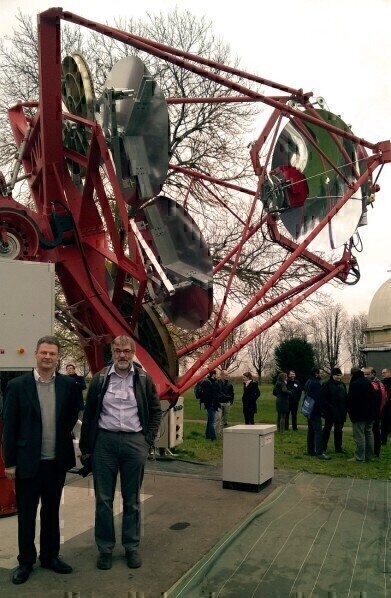-
 L to R Christopher Townsley (CTA Project Manager) and Professor Tim Greenshaw (CTA UK PI) at the launch of the CTA Telescope Prototype in Paris. (Credit: STFC)
L to R Christopher Townsley (CTA Project Manager) and Professor Tim Greenshaw (CTA UK PI) at the launch of the CTA Telescope Prototype in Paris. (Credit: STFC)
News
British Scientists Contribute Super-Fast Camera to International Astronomy Project
Feb 23 2016
A camera built by UK scientists and designed to detect the short flashes of light produced by gamma rays as they hit the earth’s atmosphere, was inaugurated as part of the recent launch of the Gamma-ray Cherenkov Telescope (GCT) prototype at l’Observatoire de Paris. The prototype telescope and camera will undergo rigorous testing over the next year, then the team intends to build 35 cameras and telescopes for the CTA Observatory based on the results of the testing process.
Funded by the STFC, the camera, that operates more than a million times faster than a standard digital SLR, uses high-speed digitisation and triggering technology capable of recording one billion images per second and is sensitive enough to resolve single photons of light. Camera testing has now begun with the aim of producing CTA's first Cherenkov data on the night sky.
Professor Tim Greenshaw from the University of Liverpool and one of the UK co-ordinators for the project said “It’s fantastic to see the prototype GCT camera, designed in the UK and built here with the help of our GCT colleagues now in operation. This is a first for the CTA project. It’s great that UK scientists and engineers are able to contribute to international projects like CTA and hence will be able to use the data from the project to deepen our understanding of the high energy universe.”
In addition to researching the sources of these gamma rays in Space the study of such high energy gamma-rays could also lead to further understanding of topics in fundamental physics like dark matter and relativity, with the potential to discover new particles and/or violations in fundamental theory.
UK Universities involved in the CTA project include the University of Leicester, University of Liverpool, University of Durham and Oxford University.
The Cherenkov Telescope Array (CTA) is an initiative conducted by many countries worldwide to build the next generation ground-based very high energy gamma-ray observatory. With its unprecendented energy coverage and sensitivity, it will uncover the Universe in the most extreme window of the electromagnetic spectrum: the very high energy gamma-rays. Such energetic photons are emitted by the annihilation or desintegration of particles and from the acceleration of electrons, positrons and atomic nuclei in the most extreme sources of the Universe.
CTA will explore a wide variety of particle accelerators in the Universe, from the nearby pulsars, micro-quasars, stellar winds and supernova to active galactic nuclei, gamma-ray bursts and clusters of galaxies. These sources accelerate particles to energies much larger than in man-made accelerators such as the LHC. CTA will also probe fundamental physics such as the violation of the Lorentz invariance and the nature of dark matter.
CTA will discover thousands of sources in the TeV band, while as of now we barely know a hundred such emitters. CTA will be the first ground-based gamma-ray observatory open to the scientific community at large.
Digital Edition
Lab Asia Dec 2025
December 2025
Chromatography Articles- Cutting-edge sample preparation tools help laboratories to stay ahead of the curveMass Spectrometry & Spectroscopy Articles- Unlocking the complexity of metabolomics: Pushi...
View all digital editions
Events
Jan 21 2026 Tokyo, Japan
Jan 28 2026 Tokyo, Japan
Jan 29 2026 New Delhi, India
Feb 07 2026 Boston, MA, USA
Asia Pharma Expo/Asia Lab Expo
Feb 12 2026 Dhaka, Bangladesh


















